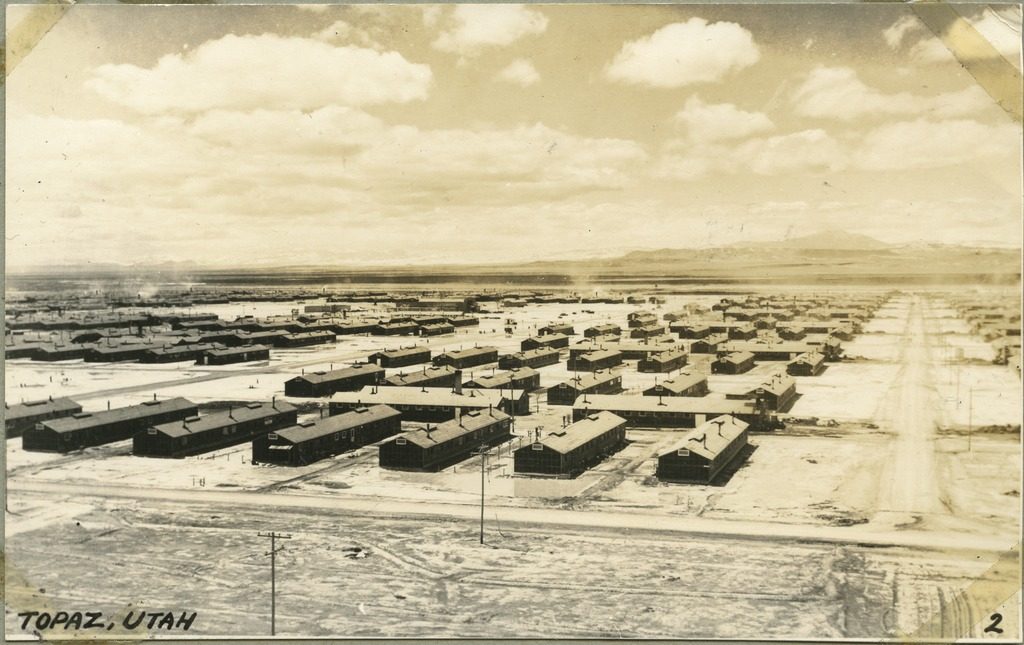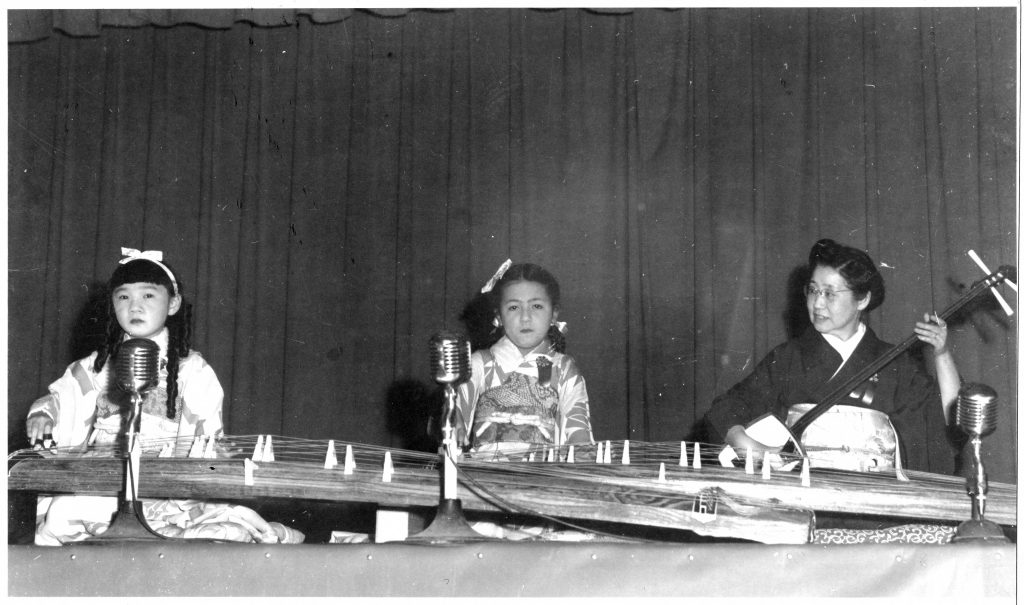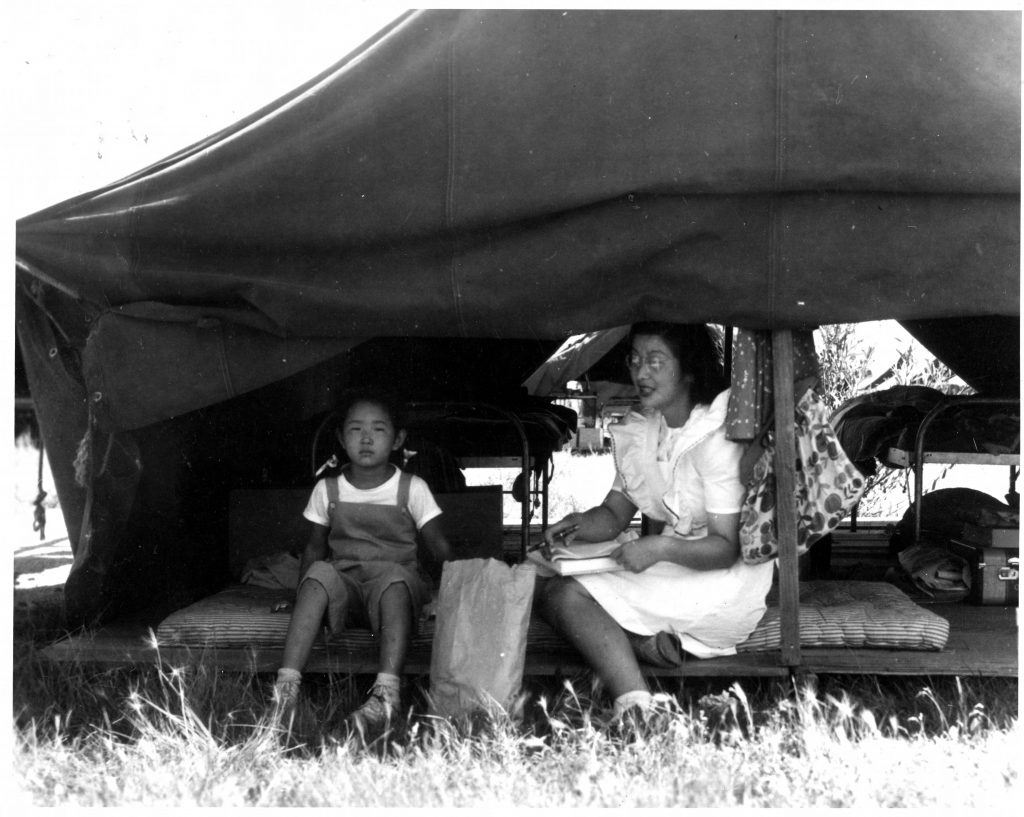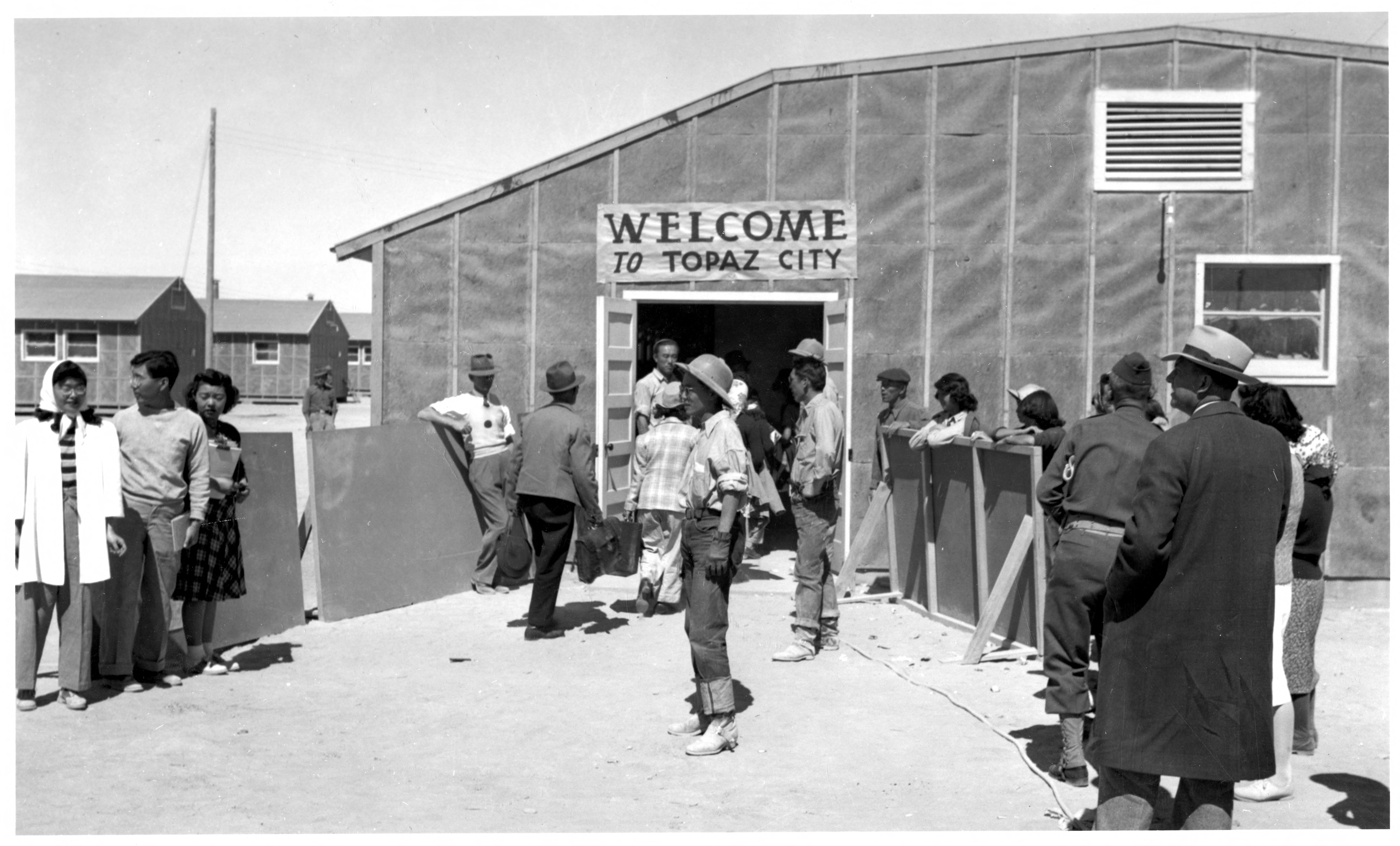September 11, 2019
The “Central Utah Relocation Center”—more popularly known as Topaz—was located at a dusty site in the Sevier Desert and had one of the most urban and most homogeneous populations of the camps, with nearly its entire inmate population coming from the San Francisco Bay Area. Topaz is perhaps best known as the site of the fatal shooting of an inmate by an overzealous camp sentry in April 1943 and for its art school, which included a faculty roster of notable Issei and Nisei artists. It was also the site of significant protest against the “loyalty questionnaire” in the spring of 1943 and of a variety of labor disputes.
The second least populous of the War Relocation Authority camps (to Amache), Topaz had a peak population of 8,130 inmates. The Topaz Museum, which opened to the public in 2015, is located in nearby Delta, Utah and today owns much of the land on which the camp was once built.
Here are ten little-known stories from Topaz concentration camp:
“Swirling Masses of Sand in the Air”

While dust storms took place at many of the WRA camps and are part of the standard narrative about these sites, they seemed to be particularly bad at Topaz even by WRA standards. Tony O’Brien, the acting project attorney, wrote in a November 1942 memo that the “dust storms are much worse than those encountered at Minidoka. The dust is more powdery in texture and penetrates every crevice on the project,” he wrote.
Maxim Shapiro, a visitor to the camp, wrote of the dust in December 1942 that “no one who has not seen it can imagine its ill effects. It penetrates everything—it fills your mouth, nostrils, the pores of your skin, your clothing—and all efforts to keep yourself or your room clean are just futile efforts…”
“We could barely see one inch ahead of us,” wrote Japanese American Evacuation and Resettlement Study (JERS) fieldworker Doris Hayashi of a dust storm in November 1942. “It swept around us in great thrusting gusts, flinging swirling masses of sand in the air and engulfing us in a thick cloud…,” wrote Yoshiko Uchida in her memoir.
The Offal Was Awful
In the spring and summer of 1943, the camp was unable to purchase sufficient meat due to outside shortages, and began serving a succession of organ meats—livers, hearts, tripe, etc.—that most inmates found unpalatable. Widespread complaints followed, including appeals to the Spanish Consul and the State Department, and calls for the firing of the chief steward. The situation was eventually resolved when the camp farming operation began to deliver beef and pork to mess halls in August 1943.
The Topaz Music School

While the Topaz Art School is relatively well-known, the equally notable Topaz Music School is much less well documented. “It is very strange because a lot of people didn’t know that there was a music studio except the people who actually went there, and even some of those people can’t remember the details about it,” recalled Kazuko Iwahashi in a 2011 Densho interview.
As with the art school, the impetus for its creation came from the relatively large number of artists/musicians among Topaz’s urban population. First organized in the Block 35 Recreation Hall, it later moved to Barrack 6 of Block 1. Teachers and students and their families spent ten days putting up walls, ceilings, and sheet rock prior to the November 1 school opening. The school offered courses in piano, vocal, violin, solfeggio, harmony, history of music, choir, ensemble, orchestra, and noh drama. The peak enrollment at the school was 653, ranging from four-year-olds to a seventy year old choral student. The school put on regular recital programs featuring the students.
As with other education endeavors, supplies and equipment were an issue. In particular, there was the matter of pianos. Though the school had access to seven pianos—many came from individual inmates and Japanese American churches in the Bay Area—this was not sufficient, and piano students were limited to mere minutes of weekly practice time. Violin students had to provide their own instruments. Nonetheless, the music school and its various performance programs provided a welcome diversion for students, teachers, and the community alike.
The Santa Anitans
Concentration camp life created some unusual groupings, alliances, and, sometimes, out groups. One of the oddest instances of the last was the fate of Santa Anitans at Topaz. Essentially the entire population of Topaz came from the San Francisco Bay Area, and nearly all came through the Tanforan Assembly Center. But one of the first groups to be removed from San Francisco in April 1942 was sent to Santa Anita instead, since Tanforan had still not been completed. This group spent nearly six months at Santa Anita and was among the last to arrive at Topaz on October 7. Even though this group shared common Bay Area roots with the rest of the Topaz population, it seems their time at Santa Anita had changed them.
Their long incarceration at Santa Anita along with the miserable conditions they faced as late arrivals at Topaz led to their being viewed by other inmates as having “a cocky attitude” and having “a chip on their shoulder.” Community Services Chief Lorne Bell described them as “something of a problem, reflecting to some degree the very unfortunate conditions which must have prevailed at that center [Santa Anita].” Their incarceration with Los Angeles people also seemed to have changed them in the view of the Bay Area people. Fred Hoshiyama, who was working as a JERS field worker, described their arrival with some degree of bewilderment:
Many of the young nisei boys who were conservative dressers came off of the bus in “zute (sic) suits” and other flashy dress wear. The girls wore their hair in styles different from the Tanforan group ala Hollywood glamour styles—either long like Veronica Lake or short and put up. Their language, their attitudes, their mannerism changed to the extent that It was easily discernible and many of the Tanforan girls and boys expressed surprise as well.
The Santa Anita group was housed in Blocks 33, 34, and 40 and apparently remained somewhat distinct from the rest of the population.
The Hawaiʻi Group
Topaz was one of two WRA camps to have a sizable contingent who had been shipped from Hawaiʻi. (Jerome was the other.) The group of 226 arrived in March of 1943 and were housed in Block 1. Most—176—were single men, most of them Kibei. Inmates and WRA staff went through great efforts to welcome them upon their arrival. Many had been interned at Sand Island previously or were family members of such internees. Most of them eventually ended up going to Tule Lake after segregation and many went on to Japan.
Hostile Reception for Outside Farm Workers

As at many camps, inmates were encouraged to go out on short term leave during the harvest season to do agricultural work in states like Utah, Idaho, and Colorado. Because so many workers were moving to the coast to take relatively well-paying war industry jobs, there were serious shortages of agricultural workers, leading to many farmers attempting to recruit incarcerated Japanese Americans. Thousands of Japanese Americans did do this, particularly in the falls of 1942 and 1943. So many left some of the camps in fact, that they created labor shortages in those camps.
While some at Topaz did leave to do such seasonal outside labor, the numbers were fewer for a couple of reasons. One was that the Topaz population was a largely urban one that included relatively few experienced farm workers. Another factor was the poor reception some farm workers received. One of the areas where laborers were most needed was in Utah County, where the WRA set up a housing camp in Provo that could house up to 400 Japanese American workers. Some of the workers reported that stores and restaurants wouldn’t serve them and that locals harassed them on the streets. In October 1943, some local youths even fired shots into the labor camp while the inmates were present. They refused to return to work until their safety could be guaranteed. Armed guards were quickly brought in, and the inmates did go back to work. But such incidents did little to encourage others to go out.
Issei and Nisei Resistance to Registration
Widespread resistance to registration emerged at Topaz, with Issei and Nisei alike questioning various aspects of the “loyalty questionnaire” and the segregated Nisei combat unit, delaying the scheduled February 10, 1943, start of registration a week.
As detailed by Cherston Lyon in her 2011 monograph Prisons and Patriots: Japanese American Wartime Citizenship, Civil Disobedience, and Historical Memory, Issei objected to the wording of question 28 that asked a population that was prohibited by law from becoming U.S. citizens to “forswear any form of allegiance or obedience to the Japanese Emperor.” They organized a committee of nine to ask that the question be changed and refused to register until the issue was resolved. With similar complaints coming from other camps, the WRA and army agreed to change the wording of the question.
Nisei also organized a Committee of 33 to demand the restoration of their civil rights before they would agree to register. But a hard line response—included threats of prosecution for violating the Espionage Act—by both local and national WRA officials along with counter protests by professed Nisei patriots broke the Nisei protest. Registration began in earnest on February 17 and was completed by February 27. While the initial number of Nisei who volunteered for the army was low, a group of volunteers formed the Resident Council for Japanese American Civil Rights, which spearheaded a propaganda campaign that helped recruit additional volunteers.
A year later, when Nisei eligibility for the draft was restored in early 1944, two groups formed to protest the continued segregation of Nisei in the army, the Topaz Citizens Committee and Mothers of Topaz. Though a faction of the former advocated draft resistance, the majority opted to protest segregation in the army but not to actively resist conscription. The latter sent a petition signed by 1,141 mothers to President Roosevelt and other national leaders objecting to the segregated Nisei military unit and to the fact that Nisei were banned from all branches of the military except the army.
Gambling Boom
Gambling became an issue at many of the WRA camps. But whereas gambling problems were mostly fueled by shadowy underground operations at other camps, they took an unusual form at Topaz. By the fall of 1943, many blocks had started bingo games as fundraisers, often for the purchase of athletic equipment. While they were effective in raising money, they had the unwanted side effect of creating bingo addicts, many of whom were children. As reports circulated of children raiding family kitties to fund their addiction, the Topaz Community Council passed an ordinance banning the bingo games, though some previously planned events were allowed to proceed at the end of the year.
To be sure, the other kind of gambling also existed at Topaz. The professional gamblers particularly targeted those who left the camp to pick sugar beets and returned to camp with a lot of cash. “The guys who stayed behind in the gambling place in camp took it all away from them in a short time,” recalled one gambler in a 1944 interview.
The Antelope Springs recreation camp
A unique aspect of Topaz was the existence of a separate recreation camp for kids. The camp education department made arrangements with the Department of the Interior to use a former CCC camp near Mt. Swasey, about forty miles west of Topaz named Antelope Springs. It served as a campsite mostly for children between the ages of twelve and fourteen, often in groups organized by the Boy Scouts, Girl Reserves or YMCA. About seventy-five kids at a time went out for stays of up to one week, accompanied by adult inmate leaders. The site was at a 7,300 foot elevation, providing a respite from summer heat, and included running mountain water, and level ground for camping.
In her Densho interview, Kazuko Iwahahsi recalled, “we slept in pup tents, two of us to a pup tent, and had open dining hall.”
“And boy, June on the lake bed out there at Topaz must have been well over a hundred degrees,” remembered Kinge Okauchi. “So this [Antelope Springs] was a great sort of respite from the hot summer.” During the summer of 1943, 338 campers went to the Antelope Springs in seven weeks.
An Extensive Library Program
In perhaps another nod to the urban roots of the Topaz inmate population, Topaz had perhaps the most extensive library system of any of the WRA camps that included a main Topaz Public Library (TPL), a library for Japanese language material, and libraries at the high school and each of the two elementary schools.
The TPL began as essentially a continuation of the library at the Tanforan Assembly Center, with books from that library being shipped to Topaz and two former library workers from there, Ida Shimanouchi and Alice Watanabe, taking the lead in setting up the new library. Work began on the library in Recreation Hall 32 on October 2, 1942. The space was unfinished and unheated, leading to days when work had to be canceled due to the cold. Inmates contributed books and magazines to the Tanforan collection, and the library was able to open to the public with a collection of nearly 7,000 books on December 1. The TPL soon moved to the Block 16 recreation hall, essentially an entire unpartitioned barrack with mess hall tables and benches running down the middle and inmate built shelves lining the walls. The collection grew to include fifty-two periodicals, including major national newspapers as well the Oakland Tribune and San Francisco Chronicle, as well as a rental collection of new books that rented for 5¢ a week.
In January 1943, the TPL was able to rotate in some books from the Salt Lake County Library at Midvale and also initiated interlibrary loan service with college libraries in Utah and the University of California at Berkeley. By the end of March 1943, the collection had grown to over 8,500 books and patronage peaked at nearly 500 a day. It became a popular place for young people to gather to socialize and do homework. Motomu Akashi recalled spending many hours in the library, since “[i]t was much more comfortable than our apartment, especially during the winter.” He called the library “my salvation” that “brought me just that small pleasure needed to overcome my depression.”
To serve the Issei and Kibei population, a Japanese language collection was formed out of donations from inmates. Opening as a part of the regular TPL in February 1943, the Japanese section became so popular that it moved to its own space in Recreation Hall 40 in May, later moving to Recreation Hall 31 in February 1944. The collection began with about 1,000 books and eventually grew to 5,000, with daily attendance of three hundred. The inmates from Hawaiʻi became frequent users of the library and put on a popular exhibition of craft items in Hawaiʻi. Later, the Japanese library hosted exhibitions of artists from the art school.
—
By Brian Niiya, Densho Content Director
The information presented here has been excerpted from Densho’s new and improved Sites of Shame project, coming to a device near you in 2020. Full citations will be included there, but feel free to post questions in the comments or email us at info@densho.org in the meantime!
[Header image: Japanese American inmates and new arrivals at the Topaz “induction center” in 1942. Photo courtesy of the Utah State Historical Society, KUED Topaz (Utah) Residents Photograph Collection.]
